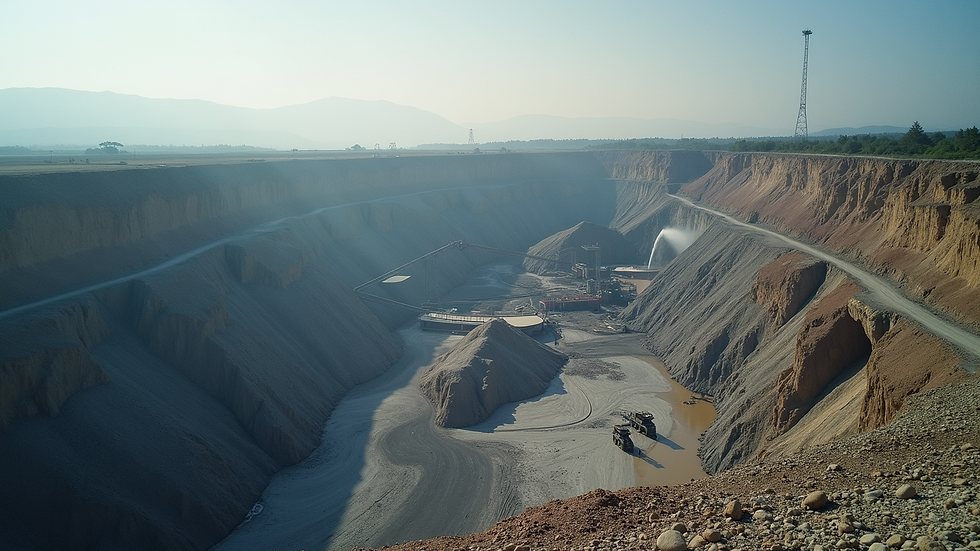Boost Your Knowledge on Tailings Management
- johncastiblanco
- Aug 8
- 4 min read
Mining operations generate significant volumes of waste materials, commonly known as tailings. Managing these tailings effectively is crucial for environmental safety, operational efficiency, and regulatory compliance. This article explores the concept of effective tailings reuse, providing practical insights and recommendations to optimise waste handling in mining projects. By understanding the principles and applications of tailings reuse, mining operations can reduce environmental impact and improve sustainability.
Understanding Effective Tailings Reuse in Mining
Effective tailings reuse involves repurposing the by-products of mining processes to reduce waste storage requirements and environmental risks. Instead of simply disposing of tailings in large dams or ponds, mining companies can explore innovative ways to reuse these materials. This approach not only minimises the footprint of tailings storage facilities but also contributes to resource efficiency.
Examples of effective tailings reuse include:
Backfilling mine voids: Using tailings to fill underground or open pit voids, which stabilises the mine structure and reduces surface waste.
Construction materials: Processing tailings into aggregates for road base, bricks, or cement production.
Land reclamation: Employing tailings to restore disturbed land areas, promoting vegetation growth and ecosystem recovery.
Implementing these strategies requires careful assessment of tailings properties, such as particle size, chemical composition, and moisture content. Tailings with high levels of contaminants or fine particles may need additional treatment before reuse.

Strategies for Effective Tailings Reuse
To maximise the benefits of tailings reuse, mining operations should adopt a systematic approach. The following strategies can guide the development of effective reuse programs:
Characterise Tailings Material
Conduct detailed laboratory analyses to determine physical and chemical properties. This information guides decisions on suitable reuse applications and necessary treatments.
Develop Tailings Processing Techniques
Implement technologies such as thickening, filtration, or drying to improve tailings handling and facilitate reuse. For example, thickened tailings reduce water content, making them easier to transport and use as backfill.
Design Reuse Applications
Tailor reuse methods to site-specific conditions and operational goals. For instance, backfilling may be preferred in underground mines, while construction material production suits surface mining sites.
Ensure Environmental Compliance
Monitor potential environmental impacts, including leachate generation and dust emissions. Establish controls to mitigate risks and comply with regulations.
Engage Stakeholders
Collaborate with regulators, local communities, and technical experts to ensure transparency and acceptance of reuse initiatives.
By following these steps, mining companies can enhance resource efficiency, reduce environmental liabilities, and improve overall sustainability.

What Does Tailings Mean in Mining?
Tailings refer to the residual materials left after the extraction of valuable minerals from ore. These materials typically consist of finely ground rock particles, water, and residual chemicals used during processing. Tailings are often stored in engineered containment structures known as tailings dams or impoundments.
The composition of tailings varies depending on the ore type and processing methods. Common characteristics include:
Fine particle size: Tailings are usually composed of silt and clay-sized particles, which can pose challenges for stability and water management.
Chemical residues: Processing chemicals such as cyanide, sulfuric acid, or flotation reagents may remain in tailings, requiring careful handling.
High moisture content: Tailings often contain significant water, necessitating dewatering or thickening before reuse or disposal.
Understanding the nature of tailings is essential for designing safe storage facilities and identifying opportunities for reuse. Poorly managed tailings can lead to environmental contamination, dam failures, and social impacts.

Benefits of Implementing Tailings Reuse Programs
Adopting effective tailings reuse practices offers multiple advantages for mining operations:
Reduced environmental footprint: Reusing tailings decreases the volume of waste stored on-site, lowering the risk of dam failures and contamination.
Cost savings: Minimising tailings storage requirements can reduce construction, maintenance, and closure costs associated with tailings dams.
Resource recovery: Some tailings contain residual minerals that can be extracted through secondary processing, adding economic value.
Improved social license: Demonstrating commitment to sustainable waste management enhances community relations and regulatory approval.
Enhanced operational efficiency: Using tailings as backfill or construction material supports mine stability and infrastructure development.
To realise these benefits, mining companies must integrate reuse strategies into their overall mine planning and environmental management systems.
Practical Recommendations for Tailings Reuse Success
For mining operations aiming to implement or improve tailings reuse, the following recommendations are essential:
Invest in research and development: Explore new technologies and methods for tailings processing and reuse.
Conduct pilot projects: Test reuse applications on a small scale to evaluate feasibility and performance.
Train personnel: Ensure staff are knowledgeable about tailings properties, handling procedures, and safety protocols.
Monitor and report: Establish monitoring programs to track environmental and operational outcomes of reuse initiatives.
Collaborate with experts: Engage consultants and technology providers specialising in sustainable mine waste management.
By following these guidelines, mining companies can achieve safer, more sustainable operations aligned with industry best practices.
For more detailed information on innovative approaches to tailings management, including technologies that reduce tailings dam size and improve safety, visit Phibion’s website.
Moving Towards Sustainable Mine Waste Practices
The mining industry faces increasing pressure to manage waste responsibly while maintaining productivity. Effective tailings reuse represents a critical component of sustainable mine waste management. By adopting innovative reuse strategies, mining operations can reduce environmental risks, lower costs, and contribute to a circular economy.
Ongoing advancements in tailings processing technologies and regulatory frameworks support this transition. Mining companies that prioritise sustainable tailings reuse will be better positioned to meet future challenges and stakeholder expectations.
Embracing these practices is not only a technical necessity but also a strategic opportunity to enhance operational resilience and environmental stewardship for generations to come.



Comments